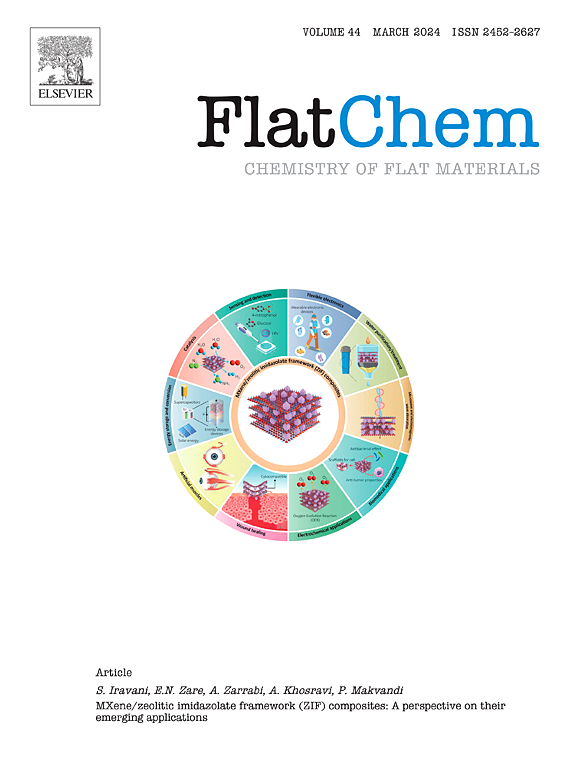基于Mn@TiO2/RGO纳米复合材料的食品中日落黄敏感传感器的研制
IF 6.2
3区 材料科学
Q2 CHEMISTRY, PHYSICAL
引用次数: 0
摘要
日落黄(SSY)是一种合成偶氮染料,广泛用于食品工业,以改善产品的外观,颜色和质地。然而,过度使用三聚氰胺会对人体健康和食品安全产生毒性和致病性。因此,一种可靠、灵敏的电化学传感器对食品样品中的SSY检测至关重要。在这项研究中,我们利用一种简单而经济的声化学方法制备了Mn@TiO2/RGO纳米复合材料,用于SSY的灵敏电化学检测。利用各种系统分析技术对制备的Mn@TiO2/RGO纳米复合材料的结晶度、组成和形貌进行了分析。Mn@TiO2与还原氧化石墨烯纳米结构的结合具有较高的比表面积、更好的导电性和显著的协同效应,显著提高了电极材料的电流响应和电子传递速率。在差分脉冲伏安法(DPV)中,Mn@TiO2/RGO/GCE修饰的玻碳电极的动态线性范围为0.02 ~ 535.62 μM,低检出限为0.028 μM。此外,Mn@TiO2/RGO/GCE传感器在检测SSY方面表现出优异的选择性、稳定性、可重复性和再现性。通过成功检测糖果和混合果汁样品中的痕量SSY,并获得可接受的回收率,证明了该传感器的实用性。这项工作介绍了一种低成本和协同的方法,成本效益Mn@TiO2与RGO相结合,用于分析商业产品中的食用色素。本文章由计算机程序翻译,如有差异,请以英文原文为准。

Development of sensitive Mn@TiO2/RGO nanocomposite-based sensor for the detection of sunset yellow in food samples
Sunset yellow (SSY) is a synthetic azo dye that is widely employed in the food industries to improve the appearance, color, and texture of products. However, excessive usage of SSY could lead to toxicity and pathogenicity to human health and food safety. Hence, a reliable and sensitive electrochemical sensor for SSY detection in food samples is essential. In this study, we utilized a simple and cost-effective sonochemical methodology to fabricate Mn@TiO2/RGO nanocomposite for the sensitive electrochemical detection of SSY. The crystallinity, composition, and morphology of the as-prepared Mn@TiO2/RGO nanocomposite were analyzed using various systematic analytical techniques. The integration of Mn@TiO2 and RGO nanoarchitecture demonstrated a high specific surface area, better conductivity, and outstanding synergistic effect that significantly enhanced the current response and electron transfer rate of the electrode material. The modified glassy carbon electrode with Mn@TiO2/RGO/GCE achieved a dynamic linear range of 0.02–535.62 μM and a low limit of detection (LOD) of 0.028 μM in the determination of SSY using differential pulse voltammetry (DPV). Furthermore, the Mn@TiO2/RGO/GCE sensor demonstrated excellent selectivity, stability, repeatability, and reproducibility in detecting SSY. The practicality of the fabricated sensor was also proved by successfully detecting trace levels of SSY in candy and mixed fruit juice samples with acceptable recoveries. This work introduces a low-cost and synergistic approach of cost-effective Mn@TiO2 combined with RGO for analyzing food colorants in commercial products.
求助全文
通过发布文献求助,成功后即可免费获取论文全文。
去求助
来源期刊

FlatChem
Multiple-
CiteScore
8.40
自引率
6.50%
发文量
104
审稿时长
26 days
期刊介绍:
FlatChem - Chemistry of Flat Materials, a new voice in the community, publishes original and significant, cutting-edge research related to the chemistry of graphene and related 2D & layered materials. The overall aim of the journal is to combine the chemistry and applications of these materials, where the submission of communications, full papers, and concepts should contain chemistry in a materials context, which can be both experimental and/or theoretical. In addition to original research articles, FlatChem also offers reviews, minireviews, highlights and perspectives on the future of this research area with the scientific leaders in fields related to Flat Materials. Topics of interest include, but are not limited to, the following: -Design, synthesis, applications and investigation of graphene, graphene related materials and other 2D & layered materials (for example Silicene, Germanene, Phosphorene, MXenes, Boron nitride, Transition metal dichalcogenides) -Characterization of these materials using all forms of spectroscopy and microscopy techniques -Chemical modification or functionalization and dispersion of these materials, as well as interactions with other materials -Exploring the surface chemistry of these materials for applications in: Sensors or detectors in electrochemical/Lab on a Chip devices, Composite materials, Membranes, Environment technology, Catalysis for energy storage and conversion (for example fuel cells, supercapacitors, batteries, hydrogen storage), Biomedical technology (drug delivery, biosensing, bioimaging)
 求助内容:
求助内容: 应助结果提醒方式:
应助结果提醒方式:


